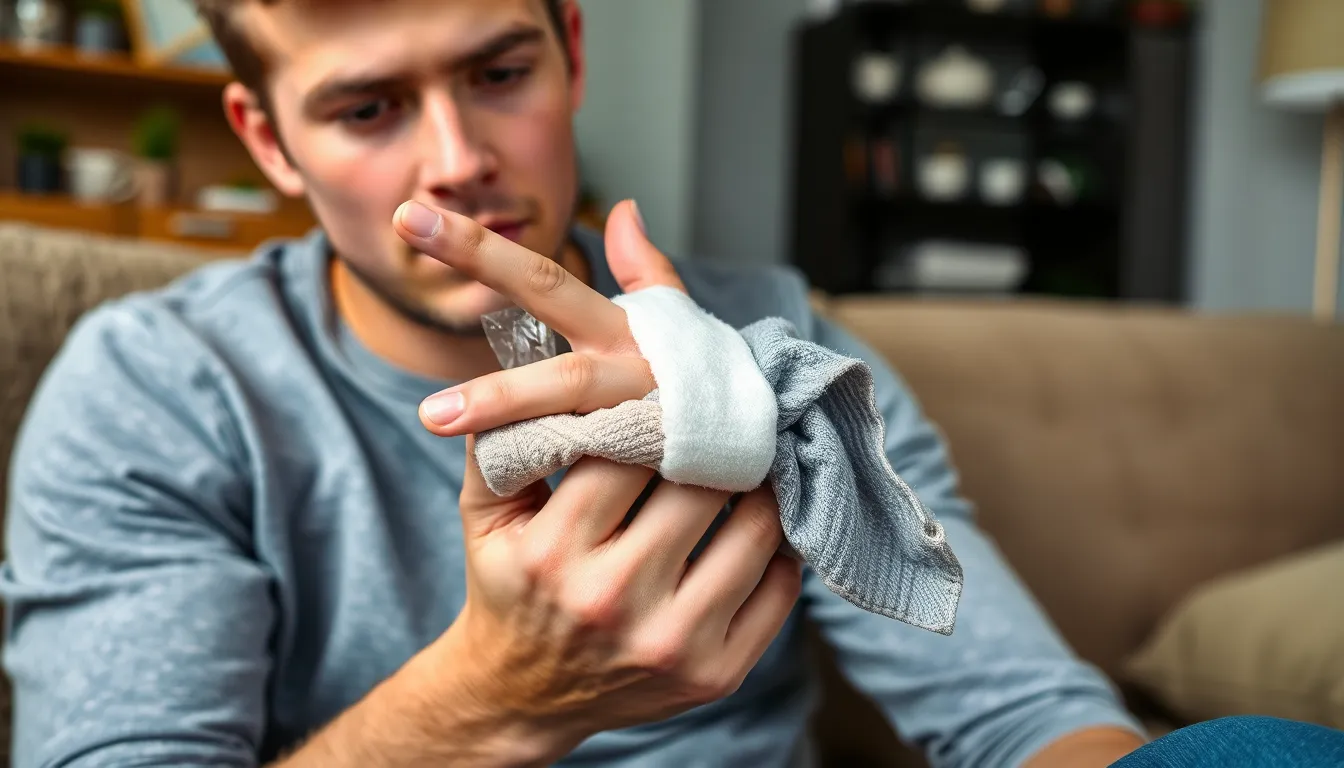Table of Contents
ToggleA jammed finger can feel like a tiny disaster, throwing a wrench into your day and making even the simplest tasks a challenge. Whether you’re an athlete who took one too many hits or just someone who miscalculated a door frame, this common injury can be frustrating. But don’t worry—fixing it doesn’t require a degree in medicine or a magic wand.
Understanding Jammed Fingers
A jammed finger is a common injury that can result in pain and inconvenience. Recognizing the causes and symptoms helps in addressing the issue effectively.
Common Causes of Jammed Fingers
Sports activities often lead to jammed fingers. Players may experience this injury during ball handling or contact with other players. Household accidents also pose risks; for instance, closing a door on a finger can cause a jam. Engaging in physical activities without proper caution increases the likelihood of injury. Children frequently sustain jammed fingers during play; roughhousing can easily lead to mishaps.
Symptoms of a Jammed Finger
Pain represents a primary symptom of a jammed finger. Individuals often feel discomfort immediately after the injury occurs. Swelling commonly accompanies the pain, increasing within hours of the incident. Bruising can develop around the affected area, indicating tissue damage. Limited mobility might occur; bending or straightening the finger can become challenging. Recognizing these symptoms allows for timely intervention and care.
Immediate Steps to Take

Addressing a jammed finger quickly can alleviate discomfort. The steps below provide guidance on handling this injury effectively.
Assess the Injury
First, evaluate the finger’s condition. Look for signs of swelling, bruising, or misalignment that indicate severity. Touch the area gently to determine pain levels. If the pain is intense or the finger appears deformed, consulting a healthcare professional ensures proper assessment. Consider the history of the injury; if it occurred during sports or an accident, this context aids in understanding its extent. A simple range of motion test can indicate if movement remains possible. Recognizing these factors lays the groundwork for effective treatment.
Apply Ice to Reduce Swelling
Applying ice effectively minimizes swelling and pain. Wrap ice or a cold pack in a cloth to prevent skin damage. Place the cold pack on the injured area for 15 to 20 minutes. This method constricts blood vessels, reducing inflammation. Repeat this process every hour for the first few hours after the injury occurs. Keeping the finger elevated while applying ice aids fluid drainage, helping control swelling. Avoid direct contact between ice and skin to prevent frostbite. Following this method significantly enhances recovery speed.
Home Remedies for Relief
Home remedies can aid recovery from a jammed finger. Simple techniques include elevation and specific finger exercises.
Elevation Techniques
Elevating the injured finger reduces swelling. Keeping the finger above heart level helps minimize blood flow to the area. Using pillows or cushions can provide support during rest. It’s beneficial to maintain elevation for 1 to 2 hours post-injury. Constant elevation promotes fluid drainage and prevents stiffness.
Finger Exercises for Recovery
Gentle finger exercises enhance mobility and promote healing. After the initial swelling subsides, start with basic range-of-motion activities. Flexing and extending the finger helps restore movement. Gradually progress to squeezing a soft object, like a stress ball, to strengthen the muscles. Consistent practice of these exercises aids in reducing stiffness and discomfort.
When to Seek Professional Help
Recognizing when to seek professional help for a jammed finger is crucial. Prompt medical attention can prevent complications and ensure proper healing.
Signs That Require Medical Attention
Severe pain that persists or worsens indicates potential injury beyond a simple jam. Noticeable deformities in the finger suggest possible fractures or dislocations. Increased swelling that doesn’t subside after ice treatment may also require evaluation. Bruising that appears extensive could signal underlying damage to ligaments or tendons. Loss of mobility or inability to move the finger adds urgency to the situation. If any of these symptoms occur, a healthcare professional should be consulted to assess the injury accurately.
Possible Treatments from Healthcare Providers
Healthcare providers may pursue various treatments based on the injury’s severity. An X-ray can help determine if a fracture exists, guiding further decisions. In mild cases, they might recommend rest, ice, compression, and elevation (RICE) as effective preliminary treatments. More serious injuries could involve splinting to immobilize the finger and promote healing. Physical therapy might be suggested to restore strength and mobility after initial recovery. In severe instances, surgical intervention might be necessary to repair damaged ligaments or bones.
A jammed finger can be a frustrating setback but knowing how to address it quickly can make all the difference. By following the immediate steps outlined and utilizing home remedies, individuals can effectively manage pain and promote healing.
Recognizing when to seek professional help is crucial to avoid complications. Observing symptoms like severe pain or noticeable deformities can guide one in making timely decisions regarding medical attention.
With proper care and attention, recovery from a jammed finger can be swift and straightforward, allowing individuals to return to their daily activities with minimal disruption.







